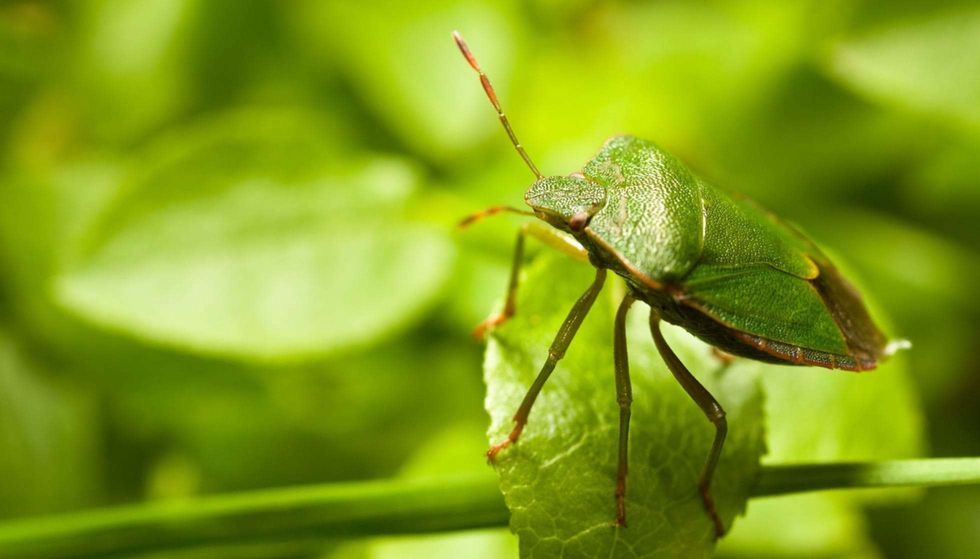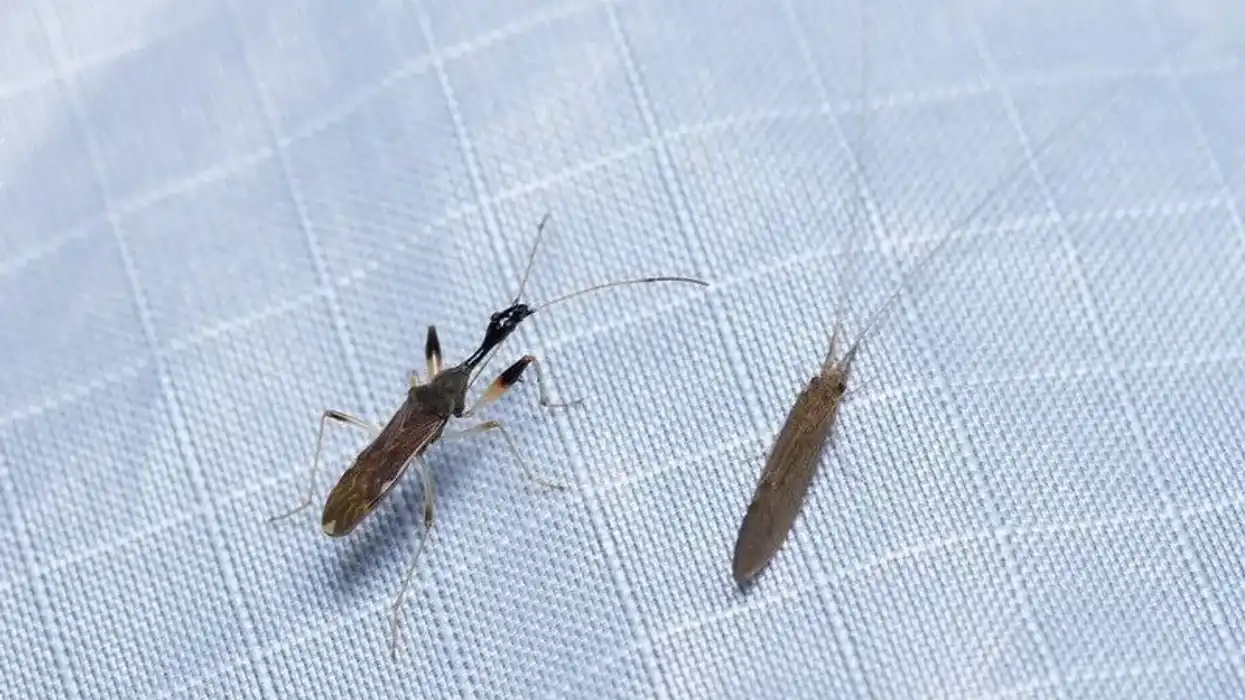The Green Stink Bug is a species of insect that is considered a pest. They are known as an invasive Stink Bug species. The common Green Stink Bug is native to America and is found all across the U.S. In contrast, the Southern Green Stink Bug is mostly found in tropical and subtropical regions of America.
The nymphs of these insects look very similar to adult Stink Bugs. They are known to have a flattened light green and brown-colored, shield-shaped body.
Adults Green Stink Bugs are generally bright green, whereas a nymph is wingless and is red-brown in color. Another striking feature to distinguish a nymph Stink Bug from an adult is the presence of a triangular plate covering the wings of an adult. Among nymphs, we don't get to see this triangular plate.
Let's have a look at some great Green Stink Bug facts. If you like these, do also try our black carpenter ant and atlas beetle facts.
Green Stink Bug Interesting Facts
What type of animal is a Green Stink Bug?
A Green Stink Bug is a type of insect with its scientific name as Acrosternum hilare. It is a commonly occurring pest that feeds on seeds, grain, nuts, and fruits. They're found in different parts of North America.
What class of animal does a Green Stink Bug Ant belong to?
The class of animals that a Green Stink Bug belongs to is Insecta.
How many Green Stink Bugs are there in the world?
Green Stink Bugs are found in the tropical and sub-tropical regions of North America.
Where does a Green Stink Bug Ant live?
A Green Stink Bug is native to America and is found all across the U.S., while the Southern Green Stink Bug is mostly found in tropical and subtropical regions of America. Stink Bugs are commonly found living in gardens, orchards, woodlands, and crop fields.
What is a Green Stink Bug's habitat?
The Green Stink Bug's common habitats are usually gardens, orchards, woodlands, and fields where they can easily feed on plants. They are found living in most of the regions of North America.
The Green Stink Bug is the most commonly occurring bug in the entire of North America. Stink Bugs are also found living in parts of England, Quebec, Florida, and California.
Who do Green Stink Bugs live with?
Green Stink Bugs prefer living with species of their kind but can also co-exist with other species of bugs and insects. Stink Bugs are seen in orchids and gardens where they can easily feed on plants. They are found living with other species of insects, other pests, and animals.
How long does a Green Stink Bug live?
The average lifespan of Green Stink Bugs is known to be 6-8 months.
How do they reproduce?
Stink Bugs mate during the early warm days of spring. The female species of Stink Bugs lay about 30-40 eggs, and fascinatingly, these eggs are barrel-shaped.
It requires around 35 days for an egg to transform into a nymph and then into adults. Hatchlings take about three to four months to come out of the eggs eventually. The female of Stink Bugs species guards their eggs and even nymphs in the early growing stages.
What is their conservation status?
According to the IUCN, the conservation status of Stink Bugs is declared as Least Concern. They are free from the threats of becoming extinct or vulnerable. There are currently 4700 species of Stink Bugs worldwide and over 200 species in America alone.
Green stink bugs are found living with species of their own kind. This Stink Bug is the most commonly occurring Bug in entire North America. They are also found living in parts of Quebec, England, California, and Florida.
Green Stink Bug Fun Facts
What do Green Stink Bugs look like?
Adult Green Stink Bugs look quite similar to other species of Stink Bugs. Nymphs look very similar to adult stink bugs.
They have flattened light green and brown-colored, shield-shaped bodies. A nymph is generally wingless and is dipped in black and red, while adults are bright red and green in color. The adults tend to have a triangular-shaped plate covering their wings which nymphs lack.
An adult Stink Bug is about 0.5-0.7 in (14-19 mm) long. Adults and nymphs have distinguished sucking mouthparts which helps them prey on fruits, plants, crops, soybean, and other pests.
How cute are they?
The tiny size and shape of these bugs (especially the Green Stink Bug nymph) make them look very cute. The color scheme of their bodies makes them all the more attractive too. However, whether the stink bugs are cute or not is subjective and varies from person to person. They do stink a bit, remember!
How do they communicate?
Green Stink Bugs (Acrosternum hilare) communicate by using an abdomen vibration technique during their courtship and mating.
How big is a Green Stink Bug?
Stink Bugs are about 0.5-0.7 in (14-19 mm) long. They are five times bigger than a Housefly.
How fast can Green Stink Bugs move?
A Southern Green Stink Bug is known to fly quite fast, about 1.1-1.2 miles (1.7-1.9 kilometers) in the period of 24 hours, and under field observations and records, they fly quickly and in a straight line at about 6.7 mph (10.7 kph).
How much does a Green Stink Bug weigh?
No information is available regarding the weight of these Bugs.
What are their male and female names of the species?
Neither the female nor the male of the Green Stink Bugs species has a specific name.
What would you call a baby Green Stink Bug?
A Green Stink Bug offspring is called a nymph.
What do they eat?
A Southern Green Stink Bug is often seen feeding on leaves, flowers, fruit, crops, soybean, pests, and caterpillars with the help of its efficient sucking mouthparts. A Green Stink Bug nymph usually prefers eating leaves and flowers during the early stages of growth. However, once it grows to be an adult, it feeds on caterpillars and different pests.
Are they harmful?
A Green Stink Bug bite is considered to be harmless to humans; however, on the other hand, it is considered to be very harmful to crops and plants. They are also called 'the agricultural pests' and tend to damage cultivated crops and plants.
Various pest management techniques are appointed to save the crops from these species of bugs. What's probably more harmful, some say, is the smell they emit to ward off their predators.
Would they make a good pet?
Holding in mind the kind of environment and environmental conditions they prefer to dwell in, keeping a Green Stink Bug as a pet is not always a great idea. They are best when left alone to live in the wild.
Did you know...
Southern Green Stink bugs are known for their foul-smelling secretion and which is the main reason they are named 'Stink Bugs'.
While the nymphs are generally wingless and have red or black body color, adults are bright green in color.
Having Green Stink Bugs
Seasonal cues usually attract Southern Green Stink Bugs to search for their own winter quarters. They prefer crawling into cracks and crevices during winters especially. Commonly, the best way to get your home rid of Stink Bugs is to seal every entry point and rub all window screens with pungent dryer sheets.
Are Green Stink Bugs beneficial?
Southern green stink bugs are known as 'agricultural pests' as they tend to cause damage to the cultivated crops and plants.
Here at Kidadl, we have carefully created lots of interesting family-friendly animal facts for everyone to discover! Learn more about some other arthropods including crab, or stag beetle.
You can even occupy yourself at home by drawing one on our green stink bug coloring pages.










